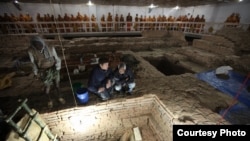Archeologists have found what they’re calling the “earliest” Buddhist shrine yet discovered.
The shrine, which they say dates back to the sixth century B.C., also pushes the date of the Buddha’s birth back 300 years, as it was widely thought he was born in the third century B.C.
Working at the Maya Devi Temple at Lumbini, Nepal, a UNESCO World Heritage site and long considered the birthplace of Buddha, a team of archeologists uncovered the timber shrine under a series of brick temples.
“Very little is known about the life of the Buddha, except through textual sources and oral tradition,” said lead researcher, Robin Coningham from the U.K.’s Durham University’s Archaeology Department.
“We wanted to go back to archaeology to try to answer some of the questions about his birth,” he added. “Now, for the first time, we have an archaeological sequence at Lumbini that shows a building there as early as the sixth century B.C.”
Laid out on the same design as the brick shrines above it, the timber structure contained an open space in the center that links to the nativity story of the Buddha himself.
Buddhist tradition records that Queen Maya Devi, the mother of the Buddha, gave birth to him while holding on to the branch of a tree within the Lumbini Garden. The researchers suggest the open space in the center of the most ancient shrine may have accommodated a tree.
Lumbini is one of the key sites associated with the life of the Buddha; others are Bodh Gaya, where he became a Buddha or enlightened one; Sarnath, where he first preached; and Kusinagara, where he passed away.
Lumbini was rediscovered in 1896 and identified as the birthplace of the Buddha due to the presence of a third-century B.C. sandstone pillar. The pillar, which still stands, bears an inscription documenting a visit by Emperor Asoka, a key figure in the spread of Buddhism, to the site of the Buddha’s birth as well as the site’s name — Lumbini.
When the Buddha died at the age of 80, he is said to have recommended that Buddhists visit Lumbini. The shrine was still popular in the middle of the first millennium A.D. and was described by Chinese pilgrims as having a shrine beside a tree.
It is estimated that half a billion people around the world are Buddhists, and by 2020, some 22 million Buddhist pilgrims are expected in South Asia; many hundreds of thousands make a pilgrimage to Lumbini each year.
The research is published in the international journal Antiquity.
The shrine, which they say dates back to the sixth century B.C., also pushes the date of the Buddha’s birth back 300 years, as it was widely thought he was born in the third century B.C.
Working at the Maya Devi Temple at Lumbini, Nepal, a UNESCO World Heritage site and long considered the birthplace of Buddha, a team of archeologists uncovered the timber shrine under a series of brick temples.
“Very little is known about the life of the Buddha, except through textual sources and oral tradition,” said lead researcher, Robin Coningham from the U.K.’s Durham University’s Archaeology Department.
“We wanted to go back to archaeology to try to answer some of the questions about his birth,” he added. “Now, for the first time, we have an archaeological sequence at Lumbini that shows a building there as early as the sixth century B.C.”
Laid out on the same design as the brick shrines above it, the timber structure contained an open space in the center that links to the nativity story of the Buddha himself.
Buddhist tradition records that Queen Maya Devi, the mother of the Buddha, gave birth to him while holding on to the branch of a tree within the Lumbini Garden. The researchers suggest the open space in the center of the most ancient shrine may have accommodated a tree.
Lumbini is one of the key sites associated with the life of the Buddha; others are Bodh Gaya, where he became a Buddha or enlightened one; Sarnath, where he first preached; and Kusinagara, where he passed away.
Lumbini was rediscovered in 1896 and identified as the birthplace of the Buddha due to the presence of a third-century B.C. sandstone pillar. The pillar, which still stands, bears an inscription documenting a visit by Emperor Asoka, a key figure in the spread of Buddhism, to the site of the Buddha’s birth as well as the site’s name — Lumbini.
When the Buddha died at the age of 80, he is said to have recommended that Buddhists visit Lumbini. The shrine was still popular in the middle of the first millennium A.D. and was described by Chinese pilgrims as having a shrine beside a tree.
It is estimated that half a billion people around the world are Buddhists, and by 2020, some 22 million Buddhist pilgrims are expected in South Asia; many hundreds of thousands make a pilgrimage to Lumbini each year.
The research is published in the international journal Antiquity.









